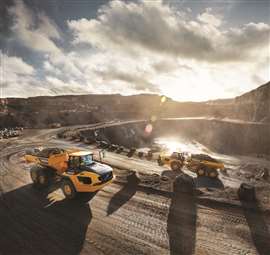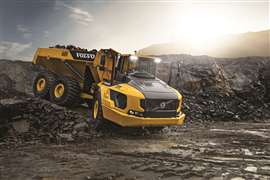Overhauling the hauler: How are the machines becoming more sustainable?
19 January 2024
As global temperatures continue to climb, so the race to build more sustainable machines hots up, as Mike Hayes reports.
The fact that we were surprised to be standing in icy rain, 12 miles south-east of Glasgow, Scotland, in the middle of October, may say something about the effect global warming has already had on us.
 The manoeuvrability and handling of ADTs on challenging terrain is key to their growing popularity in Europe (Photo: Volvo CE)
The manoeuvrability and handling of ADTs on challenging terrain is key to their growing popularity in Europe (Photo: Volvo CE)
But that was the case when a group of journalists – and influencers (also something new) – visited the Rokbak manufacturing plant in Motherwell, to hear about the company’s plans for its articulated dump trucks.
In fact, we are subjected to almost daily reminders of how the climate is changing, and why sustainability has to be a key focus for construction equipment manufacturers.
Rokbak says it is aiming for a 50% reduction in its factory operations emissions by 2030 and to be net-zero by 2040.
Reducing impact on the environment has seen Rokbak employ strategies for its articulated dump trucks, including examining alternative fuels, extending maintenance cycles and lessening maintenance consumables. In fact, the company says its research into more sustainable strategies has led to the reduction of total cost of ownership for its customers.
“A lot of work has gone into our sustainability drive over the years,” says Charlie Urquhart, Rokbak Product Manager. “Rokbak’s heritage, knowledge and resources mean that we’re constantly developing and looking to improve the trucks and the way we operate, in a manner that benefits our customers.”
Net zero goals built in
Fuel consumption is the biggest cost of operating a machine and the Rokbak RA30 and RA40 EU Stage V engines produce a fuel saving of up to 7%, when compared with the previous EU Stage IV engines, equating to lower operating costs and less impact on the environment.
Both the RA30 and RA40 ADTs (articulated dump trucks) are compatible with hydrotreated vegetable oil (HVO), a fuel that allows customers a ‘quick-hit’ on their individual net-zero targets.
Currently, the Rokbak factory operates entirely on sustainable energy sources. The company is actively working toward achieving accreditation for a zero-waste-to-landfill policy, diverting 95% of generated waste away from landfills.
Rokbak’s senior product manager Scott Pollock said the company is currently focusing on four key areas, with its hauler development: efficiency, sustainability, innovation and connectivity.
Advanced technology is another area customers expect manufacturers to be pushing, and Rokbak actually developed the latest version of its telematics system, Haul Track, hand-in-hand with some of its key customers.
 Rokbak’s RA30 and RA40 ADTs are compatible with hydrotreated vegetable oil (HVO) (Photo: Rokbak)
Rokbak’s RA30 and RA40 ADTs are compatible with hydrotreated vegetable oil (HVO) (Photo: Rokbak)
Pollock says the new system is API-enabled, “so anyone with a mixed fleet can pull all the information into their databases, whether they’re running Rokbak machines or any other.
“We understand that we’re a single-line product and rental companies and contractors will have multiple other brands.”
In terms of the machines themselves, Rokbak has upgraded the transmission on the RA30, which claims class-leading rim pull. Pollock only half jokingly says it can now climb a wall.
During the visit, we were teased with news of upgraded cabs and, in the not-too-distant future, upgraded machines, but no details as yet.
Performance through technology
Rokbak is part of the Volvo Group, but the Scottish brand operates largely autonomously. In fact, of course, in the 30 and 40 tonne classes, the machines compete in many markets.
As with every manufacturer, Volvo CE will look to build selling points into its machines; with its range of ADTs, it offers the Haul Assist suite of tools, accessed via a 254mm Co-Pilot monitor.
The fully integrated and factory-fitted system includes real-time assistance for weighing payloads, tyre pressure monitoring and on-site positional monitoring, to help with logistics.
A range of automated functions are also available, designed to maximise ease of operation and machine performance.
One of these tech upgrades is Terrain Memory, which identifies and remembers segments of road that have a slippery surface. When the hauler reaches these ‘remembered’ sections, it automatically boosts traction control.
 A Liebherr TA230 Litronic dump truck on site in Italy (Photo: Liebherr)
A Liebherr TA230 Litronic dump truck on site in Italy (Photo: Liebherr)
At the top of Volvo’s ADT range is the A60H, the largest articulated hauler on the market, which competes with its own R60 rigid hauler at what some might call a quarry/mine intersection.
Increased machine uptime is crucial for businesses looking to increase profitability wherever possible, and the A60H does a pretty good job of staying on (haul) track, with 1,000-hour service intervals that come thanks to high-performance filters. In fact, Volvo says the hauler could consume half the fluid volume of competitive machines, which has both a commercial and environmental benefit.
In a machine of this size, creating a spacious cab is not too challenging, and the A60H offers operators a centrally-positioned seat for enhanced visibility, as well as advanced suspension, low noise levels and climate control.
More than one way to haul
There have been many arguments about whether a rigid or articulated hauler is the better machine. Of course, it depends on the business, the applications and the sites.
ADT lovers maintain that six wheels improve handling on rough terrain, while fans of rigid haulers point to their generally higher hauling capacities.
Develon, taking an objective view of these arguments, has just introduced its new DA45-7 ADT, a 4x4 machine, to compete directly with rigids.
The front truck and cab of the new hauler are identical to the original 6-wheel version, but the rear dumper element more closely resembles rigid machines.
Beka Nemstsveridze is an ADT product manager with Develon. She says, “With superior operation on poorer roads, smoother surfaces and steeper terrain, the aim of our new 4x4 machine is to challenge RDTs [rigid dump trucks] in the 40-tonne class, by providing a dumper product that delivers much more than RDTs.”
 Extended uptime through extended service intervals are key to the success of Volvo’s giant A60H ADT (Photo: Volvo CE)
Extended uptime through extended service intervals are key to the success of Volvo’s giant A60H ADT (Photo: Volvo CE)
The DA45-7 has some clever tricks up its sleeve; for one thing, with a width of less than 4m, it avoids the need for special transportation.
It also benefits from a turning radius that can beat rigids in the same size class, as well as boasting the usual superior handling benefits.
The dumper unit, though, is clearly designed with the hauling of flat and heavy rocks in mind, and the mining and Develon admits it had the tunnelling industries are in mind during the hauler’s development.
Nemstsveridze says a machine like this “might be able to extend the season for a mine that normally has to be stopped for a certain period due to the rainy season.”
 Cat’s 735 ADT is a proven workhorse, but with many upgraded features developed through operator feedback (Photo: Caterpillar)
Cat’s 735 ADT is a proven workhorse, but with many upgraded features developed through operator feedback (Photo: Caterpillar)
New designs, traditional values
Caterpillar designers also see the benefits of adaptability in the design of ADTs, so they give customers the option of selecting a bare chassis, allowing them to utilise the hauler in the way that works best for their specific operations.
The Cat range of ADTs runs from payloads of 24 tonnes to 41 tonnes.
The 735 is a classic mid-range workhorse, but that’s not to say it doesn’t come with enhancements; they include a cab that’s been re-engineered using global operator feedback, new controls, an advanced automatic traction control system, stability-assist machine rollover warning system and the all-important fuel saving ECO mode.
These days, Cat is all about ‘ease of use’ technology and it claims that, with its latest hauler range, operators require up to 50% less input.
Outside of the cab, the 735 also comes in at 22% lighter than its predecessor model, in terms of unladen weight – part of the reason it boasts a 9% reduction in CO2 emissions.
POWER SOURCING GUIDE
The trusted reference and buyer’s guide for 83 years
The original “desktop search engine,” guiding nearly 10,000 users in more than 90 countries it is the primary reference for specifications and details on all the components that go into engine systems.
Visit Now
STAY CONNECTED




Receive the information you need when you need it through our world-leading magazines, newsletters and daily briefings.
CONNECT WITH THE TEAM









